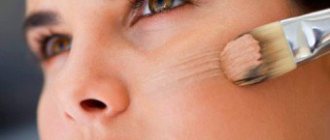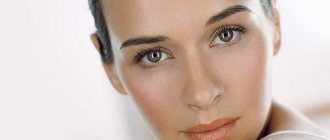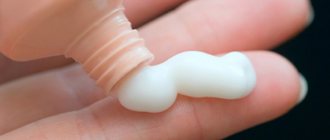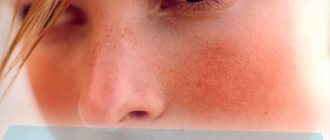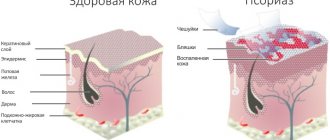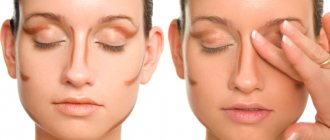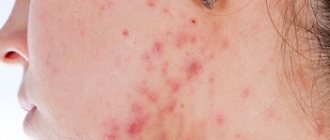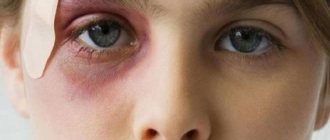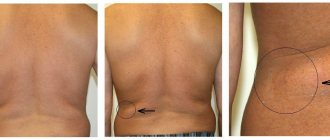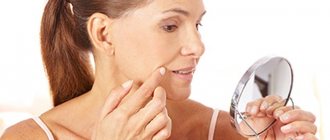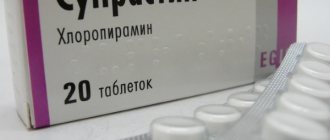Causes of redness
Redness is associated with vasodilation as a result of increased blood flow, the regulation of which is controlled by two main factors - hormones and nerve impulses. Hormones such as adrenaline bind to nerve cells in the walls of blood vessels and can cause an immediate change in the diameter of the vessels.
Small muscle cells contract to narrow the vessel (vasoconstriction) or relax to widen the vessel (vasodilation). Expansion occurs in the event of a lack of oxygen, nutrients, or an increase in body temperature and is a secondary reaction.
Redness of the facial surface occurs with vasodilation, while vasoconstriction causes blanching of the skin.
Inflammation of the face can be permanent, as with rosacea, or it can be temporary, as a reaction to irritating factors. The causes leading to redness are divided into exogenous, caused by the external environment, and endogenous, based on internal sources.
Exogenous or physiological causes include:
- temperature changes in the atmosphere;
- severe frost or cold wind;
- photodermatitis;
- increased physical activity;
- stress, emotional distress;
- excess alcohol in the body;
- medications;
- eating spicy food;
Redness on the face, which can be removed, is associated with physiological processes, but getting rid of redness that has arisen as a symptom of a skin or internal disease is much more difficult.
Redness can be caused by diseases:
- allergies;
- rosacea;
- diabetes;
- atherosclerosis;
- disorder in the gastrointestinal tract;
- alcohol intoxication;
- menopause;
- heart diseases;
- high blood pressure;
- liver cirrhosis;
- endocrine disorders;
- skin diseases;
- immune disorders.
Cheeks turn red more often in women than in men, especially those with fair skin. Aesthetically, this is perceived positively, but is often associated with internal disorders.
Nature of the phenomenon
Red facial skin is perceived by many as a cosmetic defect. Therefore, men and women strive to get rid of it with the help of cosmetics.
However, the occurrence of disorders can be associated not only with temporary negative effects, but also with pathologies in the body. Then the person will definitely need medical help.
Redness of the face appears when blood vessels dilate. It can be triggered by some kind of influence. As a result, the vascular network begins to show through the skin, causing it to redden.
People with thick skin may have a pink tint to their face. If the epidermis is thin, then a bright red or burgundy color can be observed.
Many people wonder why there are such changes. The appearance of a red face can be due to both physiological and pathological reasons. If physiology is noted, then the body’s reaction is quickly eliminated along with the irritating factor.
Pathological factors lead to disorders. In this case, redness is almost always observed. In this case, it is necessary to conduct an examination of the body. After all, internal organs can signal violations in this way.
Possible diseases
Redness of the skin is observed with malar erythema. The cause of the appearance of a red rash in the cheekbone area can be hot weather, pregnancy, stressful situations, or the ovulation period. Photodermatitis, or sun allergy, also causes facial redness due to the skin's hypersensitivity to sun exposure.
Types of redness on the face:
- redness on the cheeks and bridge of the nose;
- spider-shaped blood vessels, especially in the cheeks and nose;
- rough red pimples accompanied by itching and tingling;
- thickened red skin around the nose, on the forehead.
Skin diseases cause hyperemia, which is accompanied by raised plaques, papules, peeling, and dryness. Some skin lesions, rosacea, acne dermatitis, are characterized by excessive redness.
Diseases that cause the face to turn red:
- Juvenile acne or acne. A disorder that occurs during puberty as a result of increased activity of the sebaceous glands. On sensitive skin, in addition to acne, redness, dryness, and irritation develop.
- Acne rosacea. A chronic skin disease that has cycles of relapse and remission. Occurs more often in women with white skin. It is characterized by redness in the central part of the face, purulent pimples, and increased skin temperature in the area of inflammation.
- Atopic dermatitis. An inflammatory disease of the skin not only of the face, but also of the body, accompanied by red papules, itching, and peeling.
- Cuperosis. When the disease occurs, blood circulation in the facial area is disrupted, causing damage to small capillary vessels that are located closer to the surface of the skin. The capillary pattern becomes clearer over time, and stripes of capillaries are visible. Associated symptoms are itching, tingling, burning. Over time, the vessels, expanding more and more, are unable to contract normally. The disease develops in stages. At stage 1, hyperemia occurs for no apparent reason, periodic sensations of “hot flashes” on the skin of the face. At stage 2, a clear picture of the vascular pattern is visible. During stage 3, the disturbance of local circulation becomes chronic, and the possibility of developing inflammatory reactions increases.
Redness on the face due to rosacea will progress to rhinophyma
Doctors associate the appearance of rosacea, the most common cause of redness, with taking hormonal contraceptives, replacement therapy for endocrine system disorders, and pregnancy. There is also a connection between the appearance of rosacea and diets, bad habits, and frequent consumption of coffee and chocolate.
Redness on the face, which can only be removed by curing the underlying disease, is often caused by infections, both systemic and local:
- Erythema infectiosum. The cause of the disease is parvovirus B19. The red rash on both cheeks has a clear pattern in the form of a slap mark. Simultaneously with the lesion on the face, the rash appears on the arms and legs. The disease rarely occurs in people with a healthy immune system.
- Scarlet fever. A red skin rash appears simultaneously with a sore throat. When the disease occurs, small red bumps appear on the skin, resembling sandpaper; the skin on the arms and legs is not affected. Another symptom is a bright red tongue.
- Streptococcal pharyngitis. Inflammation of the oral mucosa caused by infection. The disease is characterized by the appearance of a red rash.
Immune disorders affect the appearance of hyperemia in the facial area:
- Allergy. This may be a reaction to cold, and in addition to redness, dryness, peeling, and itching of the skin appear. The body's response to foods and plants manifests itself not only on the face, but also on the body and hands.
- Menopause. A decrease in the production of female sex hormones, estrogen and progesterone, affects the body of women. Menopause symptoms: facial flushing, frequent urination, insomnia, depression, can last for years depending on your health.
- Drug-induced and discoid lupus. In the dosage form, a red, butterfly-shaped erythema develops on the cheeks under the influence of long-term use of sulfonamides, antibiotics, and neuroleptics. With the discoid form, red scaly spots appear on the skin of the face, which can subsequently lead to atrophy of the facial skin.
- Cluster headaches. They occur in a series of attacks lasting no more than 15 minutes. Attacks may recur from several weeks to several months. Characteristic symptoms: flushing of the face, the appearance of tears, blockage of the nasal area, acute headache.
Endocrine disorders affect color changes:
- Hyperthyroidism. An active thyroid gland causes symptoms due to a high metabolic rate: high blood pressure, sweating, redness on the face, brittle hair, weight loss, menstrual irregularities. Frequent and severe facial redness in people with hyperthyroidism occurs in the summer.
- Cushing's syndrome. The disorder is caused by excess cortisol in the body. The typical manifestation is a round face with increased hyperemia, which is especially noticeable on the cheeks. Additional symptoms include acne, muscle weakness, high blood pressure.
Cardiovascular diseases and blood diseases affect changes in complexion:
- Mitral valve stenosis. When the valve lying between the left atrium and the ventricle narrows, blood accumulates in the vessels that carry it from the lungs and back. In addition to the red face, other symptoms occur: cough, sometimes with blood, shortness of breath, dizziness.
- High blood pressure. When the heart works faster, the blood vessels narrow and the muscles contract, which leads to increased blood pressure. One of the symptoms is facial redness, other signs: shortness of breath, puffiness, memory impairment, and vision.
- Aging, obesity. Processes that affect the state of the vascular system, changes in blood circulation.
Vitamins and medications can cause redness on the face. You can remove hyperemia by refusing to take them or reducing the dosage.
Drugs that affect color change:
- vitamin B3 and all supplements including cyamine;
- glucocorticoids;
- calcium channel blockers;
- cholinergic drugs;
- opiates;
- thyrotropin;
- cyclosporine;
- doxorubicin.
People dependent on steroid medications often complain of redness, severe itching, burning and rash not only on the face, but throughout the body. This is especially true for those who use acne medications and anabolic steroids.
People suffering from agoraphobia, or panic attacks, experience intense redness in the face during an attack.
Gel "Baziron"
This remedy for inflammation on the face has an excellent calming effect. After using it, the rash goes away almost immediately. However, this gel can be found in the pharmacy in various forms depending on the specific main component. If we are talking about self-treatment, then dermatologists advise purchasing a composition that contains the least amount of benzoyl peroxide. Acceptable indicators are 2.5%. The gel should not be applied to the entire face, but only to those areas where the lesion is observed. If the skin is damaged, then this medicine should not be used. The course of treatment is at least 1 month. Tetracycline ointment for skin inflammation on the face and erythromycin have approximately the same effect.
Diagnostics
The skin is examined visually. The doctor will then conduct a survey. He must find out what the patient’s profession is, whether it affects the developing redness, whether the person is taking medications and what kind, whether there have been skin diseases in the past.
After collecting anamnesis, the person will be referred for examination, if necessary. It is suggested to test by scraping the skin, undergo testing for allergens, and take general blood and urine tests.
When to see a doctor
In most cases, there is no need to see a doctor about facial redness. The condition can be controlled and treated on your own.
If redness is accompanied by warning symptoms, then you should seek help from medical professionals:
- acne appeared;
- side effects occurred in the form of skin itching, peeling, suppuration of rashes;
- redness lasts for a long time;
- are bothered by frequent headaches;
- swelling in the mouth or throat;
- redness spreads to other areas of the body;
- signs of gastrointestinal dysfunction appeared.
Prevention
To make your face happy with its natural color, you should follow simple rules:
- To refuse from bad habits. Smoking and alcohol thin the walls of blood vessels.
- Review your lifestyle and diet. Strengthen your body, consume more fruits, vegetables, healthy fats, drink more water.
- Increase vascular tone on the face. Strengthen blood vessels with contrast washing, exercise, and avoid hypothermia.
- Avoid exposure of skin to sunlight in unacceptable amounts. In summer, take care of your skin with sunscreen and moisturizers. Sunburn cream must have at least 30 SPF.
- Use protective equipment in winter. Moisturize the skin, nourish it, do not overdry it.
- Use high-quality cosmetics and hygiene products.
- Use cosmetic procedures with caution.
- Eat foods containing vitamin P (carrots, peppers, parsley), C (lemon, onion, garlic), K (spinach), D (dairy products).
- Drink at least 1.5 liters of liquid per day, excluding coffee, tea, and tonics.
Folk remedies
In addition to creams, ointments and vitamins, various folk remedies are used at home in the form of masks, compresses, lotions, and applications.
Celery
Celery is used to make effective remedies for irritated skin:
| Means | Application |
| Petiole celery mask |
|
| Lotions from a decoction of celery leaves |
|
Herbal infusions
Effective herbal decoctions for different skin types and conditions:
| Skin type | Means |
| Irritated and inflamed | Use a decoction of calendula or string (1 tbsp of dried inflorescences per glass of boiling water). Use the product daily |
| Sensitive | Decoctions of rose, aloe, parsley, jasmine and cornflower are used. They are prepared in the same way: 1 tbsp. l. per glass of boiling water |
| Combined | Chamomile and nettle, linden and plantain are suitable. Herbs are brewed individually or in combination with each other, mixed in equal proportions. Recipe:
|
Compresses are made from herbal decoctions and infusions - they soak gauze with them and place them on the face. Hot compresses are recommended for dry and normal skin. To eliminate irritation on oily skin - cold.
Facial steam baths will be beneficial:
- Prepare 2 liters of any herbal decoction.
- They pour it into a basin and lean over it, closing their eyes.
- Cover with a thick towel.
- They wait 20 minutes.
Parsley
Parsley contains many vitamins, but the main ones are antioxidants - ascorbic acid and vitamin A, which relieve swelling and inflammation. The substances included in its composition soothe irritation, help get rid of acne and whiten the skin.
There are several types of parsley masks, they are chosen depending on skin type:
| Means | Recipe and application |
| Parsley mask for oily skin |
|
| Parsley and yoghurt for normal to oily skin |
|
| Parsley and ground oatmeal for oily skin |
|
| Acne mask |
|
Cosmetologists recommend wiping irritated or flaky skin with parsley juice or its decoction (2 tablespoons of the raw material is poured with a glass of boiling water, brought to a boil again, and then infused for 30-45 minutes).
If your face is very flaky, you can make a mask of parsley and fatty cottage cheese:
- The components are mixed in equal proportions.
- Apply to the skin in an even layer.
- They wait 20 minutes.
- Wash off with water.
A popular mask based on parsley and sour cream for any skin type:
- Chop greens.
- A couple of pinches are mixed with 2 tbsp. l. sour cream.
- Apply for 15 minutes.
- Wash off with water.
Peppermint based products
Mint contains not only essential oil and menthol, but also ascorbic acid, flavonoids, tannins, and other components. Thanks to this, it is a universal product that can be used for young and mature skin. Moisturizes, stimulates regeneration processes, eliminates irritation and redness, accelerates healing.
Effective peppermint-based products:
| Means | Recipe, application |
| Lotion |
The product helps relieve redness and inflammation after shaving, and also eliminates irritation caused by sun rays. |
| Tonic |
The tonic cleanses the skin well, helps relieve inflammation and redness, including after excessive tanning. |
Cosmetic ice cubes:
- Take a bunch of fresh mint leaves, one lemon, a glass of mineral water without gas.
- The leaves are thoroughly washed, crushed in a blender, mixed with lemon juice and added to a glass of mineral water.
- Stir.
- Pour into ice trays.
By rubbing the skin with such cubes, you can remove irritation and redness caused by any factors.
Masks
To quickly relieve redness and skin irritation, you can use homemade masks.
Cucumber
Cucumber mask is a classic of home cosmetology. It exists in several versions:
- For oily skin with irritation. Half a grated cucumber is mixed with egg white and applied to the face for 15 minutes and then washed off with cool water.
- For dry skin. The cucumber is peeled, chopped, mixed with 1 tbsp. l. sour cream and keep on the face for 15 minutes, then rinse with cool water.
Herbal
Preparation:
- Take 2 teaspoons of sage, the same amount of linden blossom.
- Brew in a glass of boiling water.
- Cover the container with them with a lid.
- After 10-15 minutes, filter the infusion through double-folded gauze.
- The resulting decoction is wiped over the face.
- A thin layer of herbal raw materials is applied to it.
- Cover the face with a terry towel.
- The wait time is 5-7 minutes.
Remove the remnants of the mask using a cotton pad and lubricate with regular nourishing cream.
Yeast based
For preparation:
- Take 10 g of dry yeast and mix with 1 tbsp. l. sour cream or kefir.
- Add the same amount of juice from any fruit.
The mask is applied to the face and washed off only after the composition has dried.
Oatmeal
Recipe:
- Mix equal amounts of oatmeal and hot milk.
- Add 1 chicken yolk, 1 tsp cottage cheese, 1 tsp. olive oil.
- The composition is cooled and kept on the face for 20 minutes.
With milk and olive oil
For preparation:
- Oatmeal is cooked in milk.
- 1 tbsp. l. the resulting product is mixed with 1 tsp. olive oil and honey.
The composition is kept on the face for 15 minutes.
Milk-vegetable
Cooking method:
- Grind the carrots on a grater.
- Mix 1 tbsp. l. product with the same amount of warm milk and oatmeal.
Keep the paste on your face for 15 minutes.
From egg yolk and honey
To prepare the mask:
- The beekeeping product is heated in a steam bath.
- Take 2 tsp. for 1 chicken yolk.
Apply the composition to the skin for 20 minutes.
From sea buckthorn
Take 1 tsp. sea buckthorn oil and 2 drops of lemon essential oil. Apply to skin for 20 minutes.
You can add mashed boiled potatoes.
From potatoes
For preparation:
- The root crop is washed, cooled and grated.
- Squeeze out the juice.
- A gauze pad is soaked in it and applied to the face.
Keep the mask on for 15 minutes.
From cottage cheese and fruits
Recipe and application:
- The fruits are crushed into puree and mixed with cottage cheese. Both components are taken in equal parts (any fruit is allowed).
- The composition is applied to the skin for 20 minutes.
With aloe juice
The pulp of the plant is crushed and mixed in equal quantities with honey. Keep the composition on the skin for 15 minutes.
Treatment methods
Etiotropic therapy consists of treating the root cause. Treatment of symptoms is necessary to reduce or remove severe symptoms not associated with internal disorders. Treatment tactics involve the use of not only medications, but also physiotherapeutic and caring procedures that protect the skin from external factors.
Medications
Redness on the face can be removed using the following products:
- keratolytic, which gently cleanse the skin, remove scales, and prevent further clogging of pores;
- anti-inflammatory, reducing existing inflammation;
- antibacterial;
- adsorbents.
Before using the products suggested in the table, you should consult a dermatologist. Resolving skin redness depends on the underlying cause, which needs to be determined.
| Effect of the drug | Name | Price in rub. |
| Anti-inflammatory | Advantan | 500 |
| Afloderm | 230 | |
| Elokom | 100 | |
| Keratolytic | Roaccutane | 1600 |
| Differin | 700 | |
| Belosalik | 200 | |
| Baziron | 600 | |
| Lorinden | 350 | |
| Antibacterial | Skinoren | 600 |
| Belogent | 130 | |
| Hyposol | 1100 | |
| Tea tree oil | 100 | |
| Absorbents | White clay | 30 |
The products used should not contain alcohol, so as not to dry and irritate the skin. It is better to select tonics based on juniper, chestnut, and hops.
Useful vitamins for facial skin:
- Vitamin D increases protective properties and regenerates the skin.
- Vitamin K, anticoagulant, helps with vascular defects, brightens the skin.
- Vitamin E, an antioxidant, restores damaged cell membranes.
- Vitamin A accelerates healing, supports collagen synthesis, and has a positive effect on the immune system.
- Vitamin C strengthens capillary walls and slows down skin aging.
When treating rosacea, heparin ointment helps well; the course of treatment should not exceed 1 week. Oxymetazoline cream and laser treatment help with rosacea.
Traditional methods
Facial redness can be controlled with detergents and warm water. Cold makes the skin even more inflamed and irritated. You can wash your face using lotions and cleansers, for example, from the company Klerasil.
Products based on:
- witch hazel;
- mint;
- eucalyptus;
- carnations.
You can use masks based on green tea, turmeric, cucumber, and ginger.
Aloe pulp is good for soothing irritated skin:
- Remove the pulp from the core of the leaf and apply to your face.
- Perform the procedure 2 times a day
Mask based on coconut oil, a natural emollient product that retains moisture in the skin:
- Soak a swab in oil and wipe your face.
- Leave until dry, then rinse with warm water.
Oatmeal mask:
- Grind pure oats to flour, mix with milk or water.
- After the oats have absorbed all the liquid, apply the mixture to your face.
- The procedure can be carried out every day, applying the mask for 20 minutes.
Cucumber mask:
- Fresh cucumber, peeled, cut into discs.
- While lying down, place cucumber slices on your face. Keep for at least 20-25 minutes.
- It is not recommended to rub the pulp into the skin so as not to cause irritation.
Green tea lotion:
- Brew green tea. Let it brew.
- After brewing, while the drink is still warm, pour the tea into a wide bowl and soak a cotton napkin in it.
- After wrung out the fabric, apply it to your face and leave for 10-15 minutes.
- You should not actively rub tea into the skin so as not to irritate it.
A non-comedogenic sunscreen applied to the skin helps.
Other methods
Redness on the face can be removed with peeling. For irritated skin, it should be gentle, properly regulating the exfoliation of the surface layer.
- Glycolic peeling . The glycolic acid molecule is very small, so it quickly penetrates the epidermis without causing irritation.
- Lactic. Lactic acid whitens the skin, brightens and strengthens the walls of blood vessels.
- Peeling with retinolic acid. This is the most superficial, gentle peeling that is gentle on the skin.
To strengthen blood vessels, we can recommend PQ Age peeling based on trichloroacetic acid. After it, a whitening, rejuvenating effect is created with minimal exfoliation.
Electroporation sessions with glycolic acid will help restore the functioning of capillaries and epidermal cells.
For hormonal disorders that occur during menopause, you should strengthen the immune system, do yoga, exercise, and massage. To strengthen the nervous system, take antidepressants: Paroxetine, Venlafaxine.
The proposed techniques will reduce the wave of “hot flashes” that affect the redness of the face.
Traditional methods of getting rid of redness on the face
You can take some measures yourself, at home:
- eating foods rich in vitamins A, C, E. They help strengthen the walls of blood vessels. These foods include: citrus fruits, beef liver, spinach, parsley, currants, etc.;
- the use of decoctions and herbal infusions for washing or wiping the face. Well suited for this: chamomile, rose hips, mint, sage;
- Masks made from natural ingredients are often used. For this, fermented milk products and clay are used. Also masks made from cucumber, potatoes, carrots;
- sometimes they use aspirin masks. It is necessary to grind several tablets into powder and dilute with water until a paste forms. The mask is applied for 8-10 minutes to the inflamed areas of the skin. You need to be careful with this recipe and use it 1, maximum 3 times a week. Because aspirin has a drying effect.
READ ALSO: How to get rid of unwanted hair on a girl’s face?
Many girls are interested in how to quickly remove redness from their faces. First, you need to visit a specialist to determine the cause of the problem.
Possible complications
Many causes of facial redness are not related to systemic diseases and do not threaten life or health. In many cases, they present aesthetic problems that can be resolved on your own or by following the advice of a doctor. If there are spider veins on the face, it is advisable to conduct an examination to exclude various pathologies.
In some cases, in order to stop the process of damage to the deep layers of the skin along with blood vessels, it is necessary to carry out a course of restorative treatment and skin nutrition in order to prevent premature aging and sagging of the skin.
If the redness on the face is not associated with an illness, then you can remove the redness yourself or in a beauty salon. But in any case, it is wiser to consult a dermatologist so as not to harm your skin.
Author: Belyaeva Anna
Article design: Vladimir the Great
